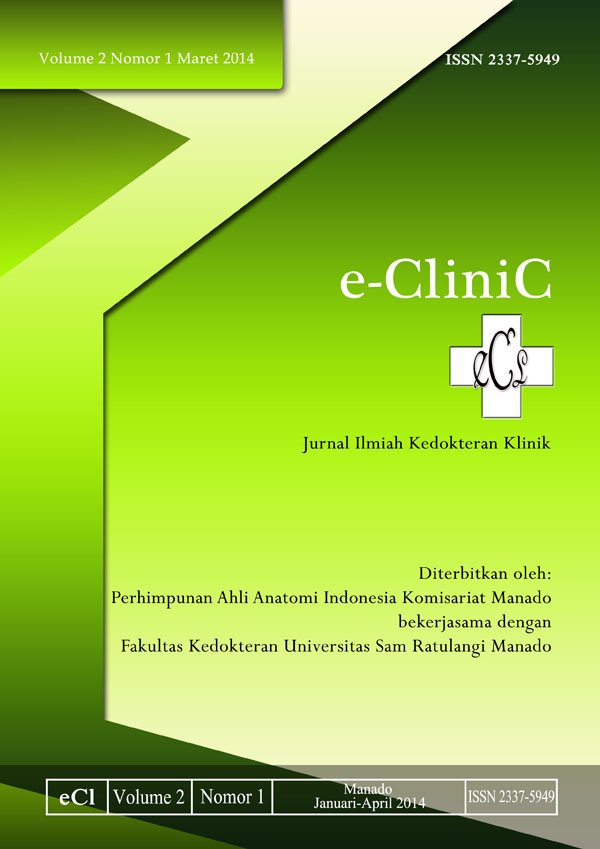PROFIL PASIEN TUBERKULOSIS PARU DI POLIKLINIK PARU RSUP PROF. Dr. R.D. KANDOU MANADO
DOI:
https://doi.org/10.35790/ecl.v2i1.3716Abstract
Abstract: Pulmonary tuberculosis in Indonesia is a global health problem and including the third leading cause of death after India and China. In 1992, the WHO has declared TB as a global emergency. The high prevalence of pulmonary tuberculosis caused by a variety of reasons, namely: low socioeconomic, health protection is not sufficient, the lack of public knowledge about pulmonary tuberculosis, treatment cost and the lack of control of tuberculosis cases, the presence of the HIV epidemic, especially in developing countries. Tuberculosis is currently common in productive age and increased mortality, especially in developing countries. This study aims to determine the profile of pulmonary tuberculosis patients in Polyclinics of Pulmonary RSUP Prof. Dr. R.D. Kandou Manado using descriptive observational method. Total sample of 52 patients. Most are between the age range 41 – 50 years. Most clinical symptoms of tuberculosis patients was cough on 51 patients. Hemoptysis was found in 17 patients, 12 patients fever and weight loss obtained in 23 patients. Based on work status and patient education obtained samples with the highest education is high school with 23 patients and self-employed with a number of 19 patients. Only 3 patients had a BMI <18.5 (underweight) and 35 patients with normal level of albumin. Based on the classification of the highest tuberculosis patient is an overview of category I and laboratory sputum results obtained for 34 patients with smear positive.
Keywords: tuberculosis, clinical symptoms, nutritional status, laboratory sputum results.
Â
Â
Abstrak: Tuberkulosis paru di Indonesia merupakan suatu masalah kesehatan dunia dan termasuk penyebab kematian ketiga setelah India dan China. Pada tahun 1992,WHO telah mencanangkan TB sebagai kedaruratan global. Tingginya prevalensi tuberkulosis paru disebabkan oleh berbagai alasan yaitu: sosioekonomi rendah, perlindungan kesehatan yang tidak mencukupi, kurangnya pengetahuan masyarakat tentang penyakit tuberkulosis paru, kurangnya biaya pengobatan dan pengawasan kasus tuberkulosis, adanya epidemi HIV terutama di negara berkembang. Tuberkulosis saat ini banyak menyerang usia produktif dan meningkatkan angka kematian terutama di negara berkembang. Penelitian ini bertujuan untuk mengetahui profil pasien tuberkulosis paru di poliklinik paru RSUP Prof. Dr. R.D. Kandou Manado dengan menggunakan metode deskriptif observasional. Jumlah sampel 52 orang pasien. Pasien laki-laki lebih banyak dibanding dengan pasien perempuan. Rentang usia terbanyak adalah antara 41-50 tahun. Gejala klinis pasien tuberkulosis terbanyak adalah batuk yaitu pada 51 pasien. Hemoptisis didapatkan pada 17 pasien, dispneu terdapat pada 16 pasien, keringat malam 24 pasien, demam 12 pasien dan penurunan berat badan didapat pada 23 pasien. Berdasarkan status pekerjaan dan pendidikan pasien didapatkan sampel dengan pendidikan terakhir terbanyak yaitu SMA dengan jumlah 23 orang pasien dan pekerjaan terbanyak yaitu wiraswasta dengan jumlah 19 orang pasien. Hanya 3 orang pasien yang memiliki IMT <18,5 (underweight) dan 35 orang pasien dengankadar albumin normal. Berdasarkan klasifikasi pasien tuberkulosis terbanyak adalah kategori I dan hasil gambaran laboratorium sputum didapatkan sebanyak 34 orang pasien dengan BTA positif.
Kata kunci: tuberkulosis, gejala klinis, status gizi, gambaran laboratorium sputum.
Downloads
How to Cite
Issue
Section
License
COPYRIGHT
Authors who publish with this journal agree to the following terms:
Authors hold their copyright and grant this journal the privilege of first publication, with the work simultaneously licensed under a Creative Commons Attribution License that permits others to impart the work with an acknowledgment of the work's origin and initial publication by this journal.
Authors can enter into separate or additional contractual arrangements for the non-exclusive distribution of the journal's published version of the work (for example, post it to an institutional repository or publish it in a book), with an acknowledgment of its underlying publication in this journal.
Authors are permitted and encouraged to post their work online (for example, in institutional repositories or on their website) as it can lead to productive exchanges, as well as earlier and greater citation of the published work (See The Effect of Open Access).







